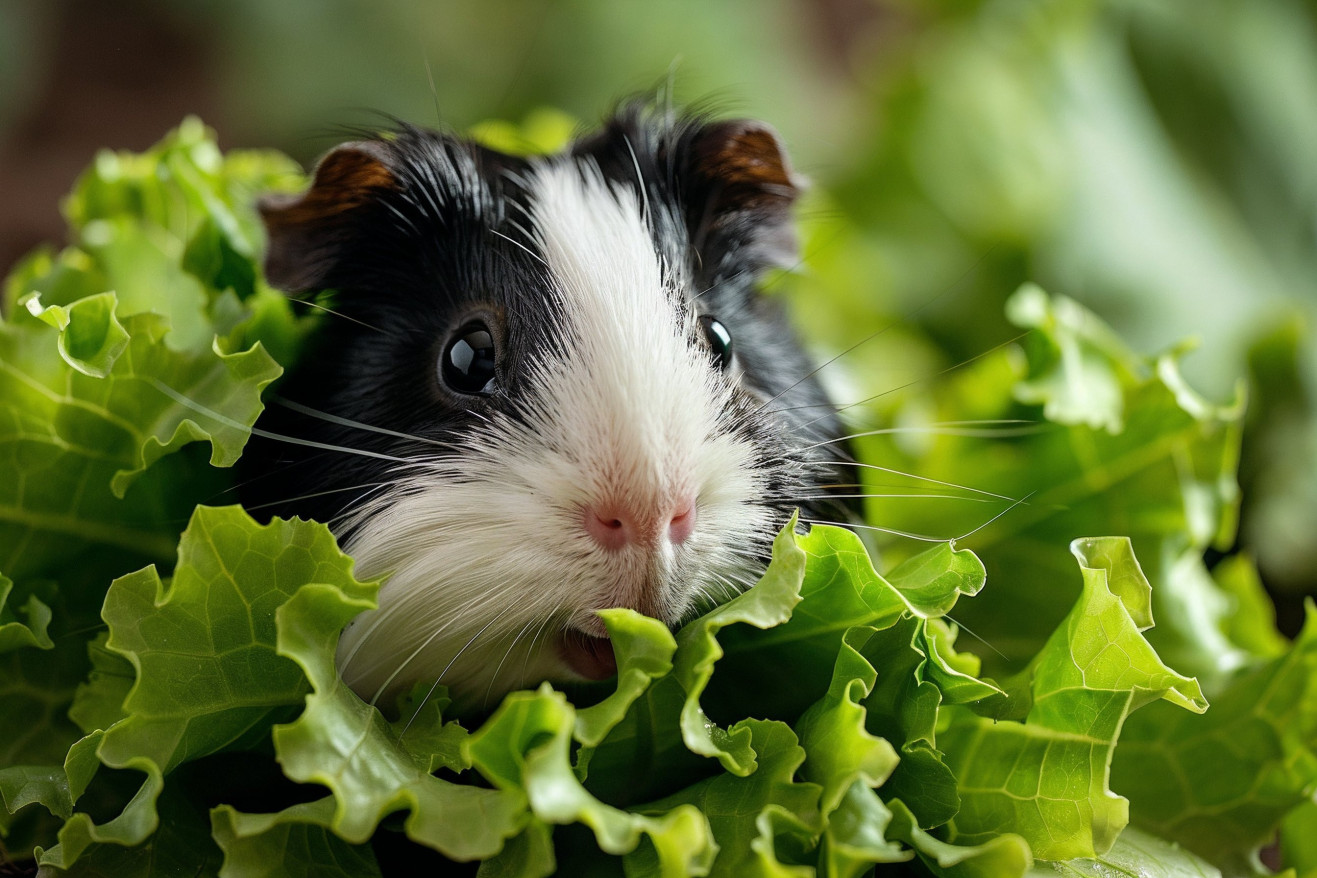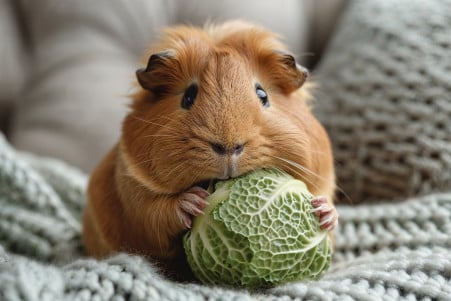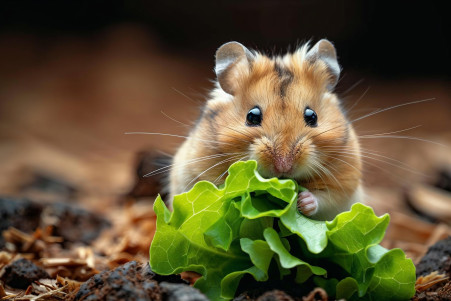Can Guinea Pigs Eat Lettuce? Nutritional Facts and Safe Types
2 March 2024 • Updated 2 March 2024

If you’re trying to make sure that your guinea pig has a well-rounded diet, you may be wondering if lettuce is a good option. It turns out that guinea pigs can eat a number of different lettuces, including Romaine, Green Leaf, and Butterhead, all of which have important nutrients. However, Iceberg lettuce should be avoided due to its lack of nutrients and high water content.
We will reference veterinary nutritional research and animal care recommendations to explain exactly how to feed lettuce to guinea pigs. We will also compare different types of lettuce, their nutritional information, and how they contribute to a guinea pig’s diet. By the end of this article, you will have a comprehensive understanding of the benefits and potential drawbacks so that you can make the best choices for your pet’s health and nutrition.
Can guinea pigs eat lettuce?
Lettuce Nutrition Facts for Guinea Pigs
Lettuce is a hydrating, nutritious part of a guinea pig’s diet, particularly Romaine, Green Leaf, and Butterhead lettuce. According to Healthline, Romaine lettuce is packed with essential nutrients like vitamins C, K, and A, as well as important minerals like calcium, magnesium, and potassium.
The Arizona Exotics Veterinary Clinic explains that these nutrients are important because guinea pigs, like people, can’t produce their own Vitamin C and need to get it from their diet. Guinea pigs need Vitamin C to avoid scurvy, a common health problem, and they also need fiber to keep their digestive system healthy.
On the other hand, Iceberg lettuce, while hydrating, is low in nutritional value and fiber, which is important for a guinea pig’s health. Iceberg lettuce does contain some vitamins A and K, but they are in much lower quantities than the other types of lettuce. As a result, Iceberg lettuce is not as nutritious for guinea pigs due to its low nutritional value.
Lettuce should be fed to guinea pigs in the context of their other nutritional needs. In general, guinea pigs should be fed about 1/2 to 1 cup of leafy greens, including lettuce, per day. This amount helps ensure that the guinea pig gets the right balance of hydration, fiber, and vitamins without getting too much of any one food.
The Healthiest Lettuce for Your Guinea Pig
Not all lettuces are created equal, and when it comes to the best leafy greens for your guinea pig, romaine is a great choice. Not only is it safe, but it’s also nutritious and high in Vitamin C, an important nutrient that guinea pigs can’t make on their own.
While Green Leaf lettuce is another lettuce that’s high in Vitamin C, it’s also high in calcium, which can lead to bladder stones. Red Leaf lettuce has a good amount of vitamins A and K and less calcium, making it a better choice for more frequent feeding.
Butterhead lettuce, also known as Boston, is another lettuce that’s high in potassium, Vitamin A, and Vitamin K, but it’s also high in calcium. Like Green Leaf lettuce, it should be fed in moderation. GuineaDad stresses the importance of a balanced diet, and notes that lettuce has a sedative effect.
Hepper recommends introducing lettuce to your guinea pig’s diet slowly, starting with a small piece to see how your pet reacts. This is especially important when feeding lettuces that are high in calcium, as you’ll want to make sure that your pet doesn’t experience any urinary or digestive issues. With the right choices and portion control, lettuce can be a healthy and hydrating addition to your guinea pig’s diet.
Serving Sizes: How Much Lettuce Should You Feed Your Guinea Pig?
Lettuce and other vegetables should be included in your guinea pig’s diet, but it’s important to feed them in moderation. According to GuineaDad, the recommended daily serving size for fresh vegetables, including lettuce, is 1 cup per guinea pig. This should be a mix of vegetables to ensure that your guinea pig gets a wide range of nutrients, and a medium-sized piece of lettuce is a good serving size when combined with other leafy greens.
That said, Guinea Pig Cages notes that hay should make up at least 90% of a guinea pig’s diet. Hay is important for dental health and proper digestion, and if you feed your guinea pig too many vegetables, they may eat less hay, which can lead to dental and digestive problems.
Guinea Pig Cages also recommends feeding pellets, which are part of a guinea pig’s diet, in limited amounts; about 1/8 cup of high-quality pellets per day. High-quality pellets, like those made by Oxbow or KMS, are designed to be fed in conjunction with a guinea pig’s primary diet of hay and fresh vegetables, so they provide the necessary nutrients without the potential problems of overfeeding.
It’s also important to note that guinea pigs have sensitive digestive systems, so sudden changes in their diet can lead to gastrointestinal upset. To avoid this, make sure to introduce new vegetables gradually and feed your guinea pig a variety of vegetables. Also, make sure they always have plenty of hay to eat, which will help ensure that they get the nutrients they need without overdoing it on any one type of food.
How Guinea Pigs Digest Food
Guinea pigs have a unique digestive system that is well-suited for processing fibrous plant material, like lettuce. The large intestine, which includes the cecum, acts as a fermentation vat in which bacteria ferment fiber, releasing nutrients, according to Supreme Petfoods. This is especially important for guinea pigs since they can’t make their own Vitamin C and must get it from their food.
Guinea pigs also have a unique behavioral adaptation called coprophagy, which is the consumption of their own caecotrophs, that enables them to absorb essential nutrients that weren’t absorbed during the first pass through the digestive system. as noted by Zooplus Magazine, this is especially important for guinea pigs to absorb B vitamins and other nutrients that are produced by the gut flora.
It is important to note that when feeding guinea pigs lettuce or any other food, it’s important to be careful, as described by PMC, guinea pigs are prone to gastrointestinal diseases that can be caused by dietary changes.
To avoid these issues, it’s important to slowly introduce new foods to the guinea pig’s diet so that their gut flora can adjust to the new food without causing stress or an imbalance. This is important to maintain the balance of a guinea pig’s digestive system.
Navigating the Risks: How to Feed Lettuce to Guinea Pigs
While it’s important for pet owners to understand the risks of feeding lettuce to guinea pigs, it’s also important to know how to mitigate those risks. For example, the warning against feeding guinea pigs iceberg lettuce from places like Penthouse Piggies is based on the fact that it has low nutritional value and is mostly water.
Meanwhile, the potential for pesticide residue is a concern for all types of lettuce. However, pet owners can minimize this risk by washing the lettuce thoroughly before feeding it to their guinea pigs.
That said, even washing the lettuce may not remove all risks, especially when it comes to bacterial contamination.
For example, reports from places like Verywell Health and Consumer Reports have shown that E. coli and listeria outbreaks associated with leafy greens have been linked to the water used to irrigate the plants or contamination during the handling and packaging process, demonstrating the potential danger.
While pet owners can reduce the amount of bacteria on lettuce by soaking it in a solution of water and vinegar and then rinsing it, it won’t remove all bacteria.
Once lettuce has been added to a guinea pig’s diet, it’s important for pet owners to monitor their pets closely. This includes watching for signs of digestive distress, which could indicate that the guinea pig is having an adverse reaction.
If it turns out that a guinea pig can’t tolerate lettuce, pet owners should look for other sources of nutrition, such as other safe vegetables or vitamin-fortified pellets.
In order to keep guinea pigs healthy and safe, pet owners need to make sure they’re making informed dietary decisions and that they’re monitoring their pets closely and practicing good food safety.
Conclusion: Lettuce and Your Guinea Pig’s Diet
So, what have we learned about guinea pigs and lettuce? We’ve discovered that Romaine, Green Leaf, Red Leaf, and Butterhead lettuces are safe and nutritious for guinea pigs, while Iceberg lettuce is not due to its lack of nutritional value. Knowing the nutritional values of these lettuces and feeding them in moderation are the keys to keeping your guinea pig healthy.
Lettuce is an important part of a guinea pig’s balanced diet, helping to keep them hydrated and providing essential vitamins, especially Vitamin C, which is vital for guinea pigs.
However, it’s important to add lettuce to your guinea pig’s diet carefully, taking into account the potential dangers of pesticide exposure and the importance of a balanced diet. By introducing lettuce slowly and watching your guinea pig for any signs of trouble, you can help prevent digestive issues and make sure your guinea pig enjoys the benefits of lettuce.
In the end, it’s important to be mindful of the choices we make when it comes to our guinea pigs’ diets. By doing so, we can make sure we’re not only giving them a well-rounded diet but also protecting their health and well-being, so they can continue to enjoy a diet that includes the safe lettuces they love.


